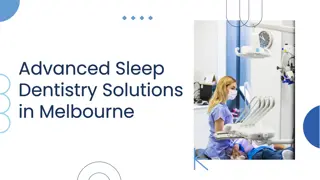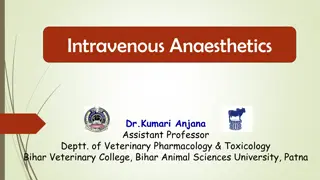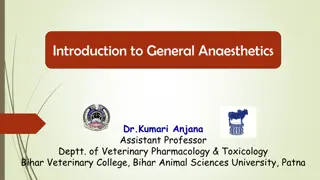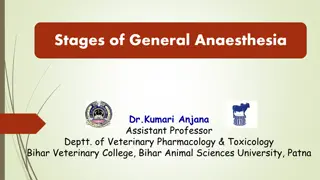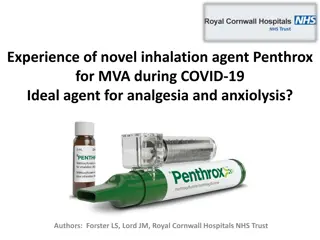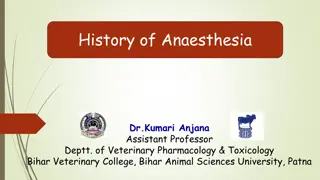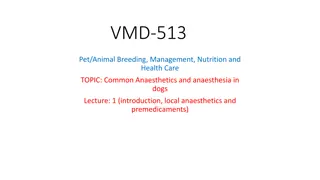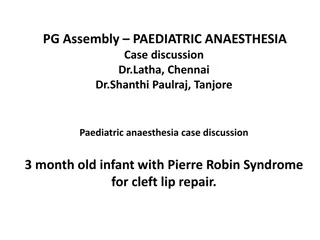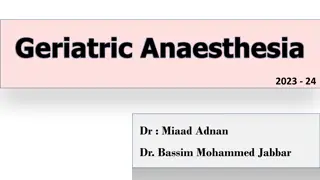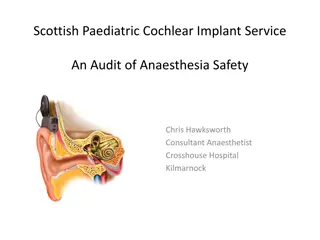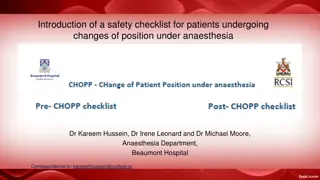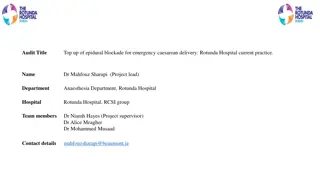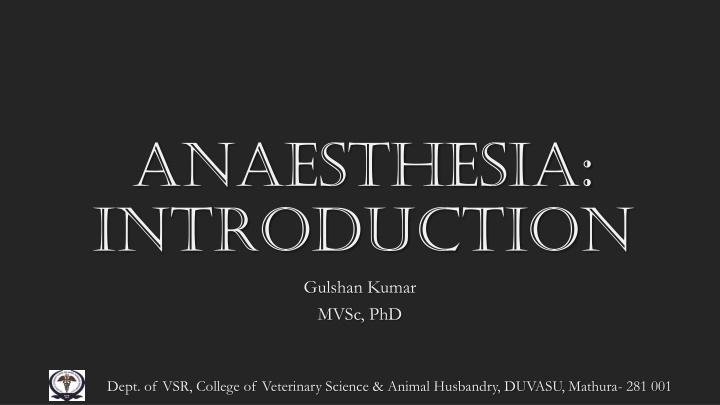
History and Types of Anaesthesia in Veterinary Science
Explore the history and types of anaesthesia in veterinary science, from ancient practices to modern methods like surgical and balanced anaesthesia. Learn about the evolution of anaesthetic drugs and their effects on pain perception and behaviour in animals.
Download Presentation

Please find below an Image/Link to download the presentation.
The content on the website is provided AS IS for your information and personal use only. It may not be sold, licensed, or shared on other websites without obtaining consent from the author. If you encounter any issues during the download, it is possible that the publisher has removed the file from their server.
You are allowed to download the files provided on this website for personal or commercial use, subject to the condition that they are used lawfully. All files are the property of their respective owners.
The content on the website is provided AS IS for your information and personal use only. It may not be sold, licensed, or shared on other websites without obtaining consent from the author.
E N D
Presentation Transcript
Anaesthesia: Introduction Gulshan Kumar MVSc, PhD Dept. of VSR, College of Veterinary Science & Animal Husbandry, DUVASU, Mathura- 281 001
Anaesthesia- an (absence)+ aesthesia (senses)laKkkwU;rk Derived from Gr. Anaisthaesia, meaning insensibility. 500-600 BC: Sushruta has described sangya harana (laKkgj.k with (wine) madya (e|) --- : Bhojprabandha describes Mohachurna (eksgpw.kZ --- : Charak has described Teekshana sura (rh{.k lqjk 1540 AD: Paracelsus Produces Ether and reports it to have soporific effect (causing drowsiness) on birds . 1800 AD: Humphrey Davy Nitrous oxide probably has anaesthetic properties 1824 AD: H.H. Hickman demonstrated that pain could be alleviated by administering a mixture of Nitrous oxide and Carbon dioxide in dogs. Dept. of VSR, College of Veterinary Science & Animal Husbandry, DUVASU, Mathura- 281 001
1832 AD: Liebig discovers Chloroform 1842 AD: Ether used in Humans 1844 AD: Horace Wells discovers anaesthetic properties of Nitrous oxide 1847 AD: Flourens uses choloform in animals and JY Simpson uses it in humans. 1878: Humbert describes use of Chloral Hydrate in horse. 1878: Anrep suggested use of cocaine as local anaesthetic. 1885: G.L. Corning induced spinal anaesthesia in dogs. 1930: Pento barbital discovered 1934: Thiopental developed Dept. of VSR, College of Veterinary Science & Animal Husbandry, DUVASU, Mathura- 281 001
Algesia Analgesia Tranquillisation Perception of Pain or presence of pain Absence of Pain or freedom from pain Behavioural change with relief from anxiety, relaxation with awareness of surroundings. The patient may appear indifferent to pain. A state of central depression with drowsiness, response to painful stimulus but generally unaware of surroundings. Drug induced deep sleep with or without analgesia, from which arousal is not easy. A trance resembling sleep or an artificially induced sleep due to moderate CNS depression. The patient can be readily aroused from such trance/sleep. drug-induced unconsciousness, characterized by controlled, reversible depression of the CNS and analgesia., the patient is not arousable by noxious stimulation. Sensory, motor, and autonomic reflex functions are attenuated. Sedation Narcosis Hypnosis General Anaesthesia Dept. of VSR, College of Veterinary Science & Animal Husbandry, DUVASU, Mathura- 281 001
Surgical Anaesthesia Balanced Anaesthesia A stage or plane of general anaesthesia with unconsciousness, muscle relaxation and sufficient analgesia to facilitate painless surgery. Anaesthesia affected by a combination of drugs individually discharging the component effects in anaesthesia namely, consciousness, analgesia, muscle relaxation, and alteration of autonomic reflexes the There is dissociation of the thalamocortic and limbic systems. This form of anaesthesia is characterized by a cataleptoid state in which the eyes remain open and swallowing reflexes remain intact. Loss of sensation in circumscribed body area. Dissociative Anaesthesia Local analgesia (anaesthesia) Regional analgesia (anaesthesia) Insensibility in a larger (limited) body area (e.g., paralumbar nerve blockade). Dept. of VSR, College of Veterinary Science & Animal Husbandry, DUVASU, Mathura- 281 001
Why? Restraint, Freedom from pain and anxiety, Muscular relaxation, It may be desired to aid in: Safe transportation of wild and exotic animals Various diagnostic and therapeutic procedures Dept. of VSR, College of Veterinary Science & Animal Husbandry, DUVASU, Mathura- 281 001
Types: Inhalation anaesthesia: anaesthetic gas or its vapours are inhaled by the patient. Injectable anaesthesia: injection of anaesthetic drugs either i.v. or i.m. or s.c. Oral/rectal anaesthesia: liquids or suppositories. Local/conduction anaesthesia: the agent is injected locally or around a nerve trunk. Electronarcosis: sleep induction by passage of electric current through cerebrum Acupuncture: inserting fine needles at specific points to produce analgesia. Hypothermia: local or corporeal. Dept. of VSR, College of Veterinary Science & Animal Husbandry, DUVASU, Mathura- 281 001
Considerations: Anaesthesia: deliberate, reversible state of unconsciousness, by administration of potential toxicants, in a controlled manner. They ll be introduced into the body, They will interact with the body systems to cause their effect, CNS, CVS, Respiratory .which are all vital systems Will need to be metabolised (most of them ) Will need a route to be eliminated And they are all toxic Dept. of VSR, College of Veterinary Science & Animal Husbandry, DUVASU, Mathura- 281 001
Considerations: Pharmacology: Biological Variation: BMR- small and large animals, smaller the animal, larger the dose. Fatty animal-has usually a lower BMR Animals in poor general condition require lesser anaesthetic Age- young (not to mature system) and old (not so efficient system) Dept. of VSR, College of Veterinary Science & Animal Husbandry, DUVASU, Mathura- 281 001
Considerations: Pharmacology: Pharmaco-genetic differences: Animals may have genetic makeup causing varied effects, Rabbits hydrolyse atropine, Some breeds of pig are susceptible to malignant hyperthermia, Circadian rhythm may affect the MAC of inhalant anaesthetics. Dept. of VSR, College of Veterinary Science & Animal Husbandry, DUVASU, Mathura- 281 001
Considerations: Pharmacology: Pharmaco-kinetic differences: For GA, the agent should have access to the CNS Inhalant agents are primarily exhaled, some quantities are iminated via skin, faeces, urine, mucous membranes, but Injectables depend on redistribution, biotransformation (mainly in liver) and elimination through kidneys (no control over elimination, hence some consider them to be more dangerous than inhalant agents) When given i.v., they bypass absorption phase, so less variation in onset and intensity of action. Dept. of VSR, College of Veterinary Science & Animal Husbandry, DUVASU, Mathura- 281 001
Considerations: Pharmacology: Pharmaco-kinetic differences: Once in blood, its binding (which is reversible and affected by plasma pH, hydration status) with proteins or other macromolecules affect their capability to penetrate cell membrane, hence also their storage, metabolization and excretion. When by circulation the concentration in the vessel-rich tissue goes higher than that in blood, it begins to re-enter circulation, Anaesthesia lightens when the agent is redistributed (concentration in brain falls) and anaesthetic accumulates in muscle, fat and vessel- poor tissue Dept. of VSR, College of Veterinary Science & Animal Husbandry, DUVASU, Mathura- 281 001
Considerations: Pharmacology: Pharmaco-kinetic differences: The blood-brain barrier limits the penetration of non-lipophilic, ionised or protein-bound drug. Within moments of tissue-uptake and redistribution, elimination begins (vessel rich liver is primary site of biotransformation and the kidney for excretion). Without this biotransformation or any delay, the effect of the drug may be prolonged. Dept. of VSR, College of Veterinary Science & Animal Husbandry, DUVASU, Mathura- 281 001
Considerations: Pharmacology: Pharmaco-kinetic differences: Hence, the pharmacokinetics may be modified by rate of administration and concentration of anaesthetic, physical status, muscular development, adiposity, respiratory and circulatory status, drug permeability coefficients, prior and/or concurrent drug administration, fear, recent feeding, and solubility of inhalant anaesthetics. Dept. of VSR, College of Veterinary Science & Animal Husbandry, DUVASU, Mathura- 281 001
Considerations: Pharmacology: Pharmaco-kinetic differences: Anxiety or struggling or fever raise the cardiac output and require more anaesthetic agent (chances of overdosing). Large meat meals will increase the metabolic rate. Starvation in birds (6 h) and young ones may lead to hypoglycaemia leading to altered detoxification. Liver disease-compromised protein production, less protein binding- unexpected sensitivity of drugs. Renal disease may impair excretion. Dept. of VSR, College of Veterinary Science & Animal Husbandry, DUVASU, Mathura- 281 001
Considerations: Assessment: Pharmaco-kinetic differences: Anxiety or struggling or fever raise the cardiac output and require more anaesthetic agent (chances of overdosing). Large meat meals will increase the metabolic rate. Starvation in birds (6 h) and young ones may lead to hypoglycaemia leading to altered detoxification. Liver disease-compromised protein production, less protein binding- unexpected sensitivity of drugs. Renal disease may impair excretion. Dept. of VSR, College of Veterinary Science & Animal Husbandry, DUVASU, Mathura- 281 001
General anaesthesia In veterinary anaesthesia, the major requirements are- Ethical treatment of the animal including prevention of awareness of pain, relief of anxiety and sympathetic animal handling is stage, the patient progresses from analgesia without amnesia Dept. of VSR, College of Veterinary Science & Animal Husbandry, DUVASU, Mathura- 281 001
General anaesthesia In veterinary anaesthesia, the major requirements are- an effective protocol ensuring adequate immobility and relaxation, and avoiding injury to the animal as well as the veterinarian and attendants Dept. of VSR, College of Veterinary Science & Animal Husbandry, DUVASU, Mathura- 281 001
General anaesthesia General anaesthesia: Reversible, controlled, drug induced, intoxication of the central nervous system (CNS) in which the patient neither perceives nor recalls noxious or painful stimuli. Dept. of VSR, College of Veterinary Science & Animal Husbandry, DUVASU, Mathura- 281 001
General anaesthesia General anaesthesia should produce: Analgesia (loss of response to pain) Amnesia (loss of memory) Immobility (loss of motor reflexes) Hypnosis (unconsciousness) and Skeletal muscle relaxation Dept. of VSR, College of Veterinary Science & Animal Husbandry, DUVASU, Mathura- 281 001
General anaesthesia The levels of CNS depression induced in general anaesthesia have been divided for descriptive purposes. Arthur Ernest Guedel in 1937 has described four stages of anaesthesia: Stage I: also known as stage of induction, Is the period between the administration of induction agents and loss of consciousness, Is the stage of voluntary movement, During this stage, the patient progresses from analgesia without amnesia to analgesia with amnesia. Dept. of VSR, College of Veterinary Science & Animal Husbandry, DUVASU, Mathura- 281 001
General anaesthesia .Stage 1: Excited apprehensive animals may struggle violently and voluntarily hold breath, Strong rapid heartbeat and pupillary dilatation due to epinephrine release, Salivation in some, As it progresses to stage II the animals become ataxic, and unable to stand hence recumbent. Head support is required at this stage. Dept. of VSR, College of Veterinary Science & Animal Husbandry, DUVASU, Mathura- 281 001
General anaesthesia Stage II: Stage of delirium/involuntary movement Loss of voluntary control as CNS becomes more depressed, Strong rapid heartbeat and pupillary dilatation, due to continued influence of epinephrine and cardiac arrhythmias may occur, External stimuli may cause violent reflexes, like struggling breath holding, tachypnoea and hyper-ventillation, Dept. of VSR, College of Veterinary Science & Animal Husbandry, DUVASU, Mathura- 281 001
General anaesthesia .Stage II: Eyelash, palpebral reflex, nystagmus (in horses) are present, Salivation and vomiting especially in dog and cat, Active regurgitation in ruminants, When stimulated larynx may undergo spasm, Exaggrerated reflex responses, so Stimulation of any kind should be avoided. Dept. of VSR, College of Veterinary Science & Animal Husbandry, DUVASU, Mathura- 281 001
General anaesthesia Stage III: Stage of Surgical anaesthesia Characterised by unconsciousness with progressive depression of reflexes, Further divided into four planes in human patients whereas, others suggest light, medium and deep planes. Light- until eyeball movement ceases, Medium anaesthesia is characterised by progressive intercostal paralysis, Dept. of VSR, College of Veterinary Science & Animal Husbandry, DUVASU, Mathura- 281 001
General anaesthesia Stage III: Stage of Surgical anaesthesia A medium depth of unconsciousness or anaesthesia is a light plane of surgical anaesthesia (stage III, plane 2) characterized by stable respiration and pulse rate, abolished laryngeal reflexes, a sluggish palpebral reflex, a strong corneal reflex, and adequate muscle relaxation and analgesia for most surgical procedures. Deep surgical anaesthesia (stage III, plane 3) is characterized by decreased intercostal muscle function and tidal volume, increased respiration rate, profound muscle relaxation, diaphragmatic breathing, a weak corneal reflex, and a centred and dilated pupil. If CNS depression is allowed to increase further, patients will progress to stage IV. Dept. of VSR, College of Veterinary Science & Animal Husbandry, DUVASU, Mathura- 281 001
General anaesthesia Stage IV: Stage of depression CNS extremely depressed, respiration ceases, heart continues to beat for a very short time. B.P. falls to shock level, signs of shock appear. Anal and bladder sphincters relax. Death ensues if not resuscitated immediately. If the anaesthetic is withdrawn and artificial respiration is initiated before myocardial collapse, these effects may be overcome and patients will go through the various stages in reverse. Dept. of VSR, College of Veterinary Science & Animal Husbandry, DUVASU, Mathura- 281 001
Signs of anaesthesia Respiratory signs: Stage I: Minute volume decreases especially, if pre-anaesthetics are not used. Stage II: Irregular, breath-holding is common. Stage III: Regular breathing, depth varies (premedication, surgical manipulation). Depth declines progressively. Thoracic movements diminish (weakening intercostals and diaphragm). Largely or entirely abdominal respiration. Stage IV: entirely abdominal (inspiration-abdomen expands and thorax collapses, vice-versain expiration); gasping cessation. Dept. of VSR, College of Veterinary Science & Animal Husbandry, DUVASU, Mathura- 281 001
Signs of anaesthesia Circulatory signs: Stage I&II: strong and accelerated pulse. Sometimes arrhythmias in stage II. Stage III: Regular and slightly accelerated pulse. There may be progressive bradycardia when inhalation anaesthetics are used. Pain in light Stage III may incite tachycardia and at times arrhythmias. With depth, B.P. declines and pulse weakens. Dept. of VSR, College of Veterinary Science & Animal Husbandry, DUVASU, Mathura- 281 001
Signs of anaesthesia Ocular signs: Nystagmus in horses in stage II through III. Rotation of eyeball in cattle. Eyeballs generally turned downwards in dog and cats and the third eyelid generally overlays the medial portion of cornea. Palpebral reflexes become sluggish in all. Dept. of VSR, College of Veterinary Science & Animal Husbandry, DUVASU, Mathura- 281 001
Signs of anaesthesia Pharyngeal and upper airway reflexes: Coughing and laryngospasm in response to intubation are lost in light surgical anaesthesia, but may persist into medium anaesthesia in cats. Onset of stage III: swallowing and vomiting reflexes disappear, like the laryngeal reflexes, the swallowing reflex persists into medium anaesthesia in cats. Dept. of VSR, College of Veterinary Science & Animal Husbandry, DUVASU, Mathura- 281 001
Signs of anaesthesia Other Signs: Muscle tone diminishes progressively after an initial rise in stage II. The anal sphincter tone is a good indicator of relaxation in horses which is tight is tight in stage II but relaxes with deepening anaesthesia. Deliberate anal dilatation induces increase in respiratory rate Jaw tone is important indicator in dogs. Resistance to opening mouth is lost in medium anaesthesia. Yawning may be elicited upon passive opening of mouth during transition from stage II to stage III. Flexing of limbs and shaking head on painful stimulation on digits, interdigital space and ear pinna respectively, are good indicators. Dept. of VSR, College of Veterinary Science & Animal Husbandry, DUVASU, Mathura- 281 001
Patient Evaluation and Preparation Thorough examination after collection of history as accurate as possible . The patient needs to be categorised as per physical condition, stress and pain status and anaesthetic risk. And the related issues addressed accordingly, before proceeding for anaesthesia. Dept. of VSR, College of Veterinary Science & Animal Husbandry, DUVASU, Mathura- 281 001
Patient preparation With most types of anaesthesia, it is best to have fasting for 12 hrs. Birds, neonates, and small mammals may become hypoglycaemic within a few hours of starvation, and mobilization of glycogen stores may alter rates of drug metabolism and clearance. Avoid anaesthesia in full stomach animals to avoid hazards of aspiration. Distended rumen may result impaired respiration leading to hypoxaemia and hypercapnia. Gastric rupture may result in full stomach horse during induction and casting. In most species water can be offered before pre-anaesthetic agent is administered. Dept. of VSR, College of Veterinary Science & Animal Husbandry, DUVASU, Mathura- 281 001
Patient preparation Best to have IV fluids started before induction. It maintains hydration, B.P. and an intravascular access is available for drug administration. Systemic administration of antibiotics prior to anaesthesia is debated. Some may interact with anaesthetic agents. However, they may be administered 1-2 hrs before induction. Anaemia and hypovolaemia need to be corrected with whole blood or blood components and balanced electrolytes. Effective ventilation should be ensured especially in compromised cases. Corrective measures (ionotropes, antiarrhythmic agents and diuresis) should be undertaken for decompensated heart disease which is otherwise a contraindication for anaesthesia. Dept. of VSR, College of Veterinary Science & Animal Husbandry, DUVASU, Mathura- 281 001
Patient preparation Hepatic/renal insufficiencies should be considered prior to induction. During anaesthesia, patients should, if possible, be restrained in a normal physiological position. Dept. of VSR, College of Veterinary Science & Animal Husbandry, DUVASU, Mathura- 281 001

